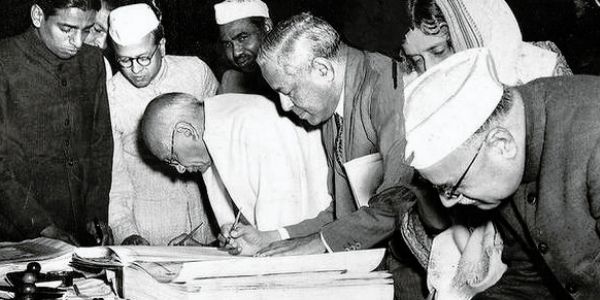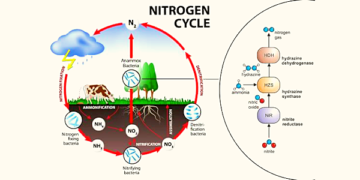We all got to know about the Indian Constitution in our school days. It is one of the essential topics that one must be aware of. Further, one needs to know the competitive exams, including the IAS exam. Besides, we also know about the IAS exam. Every year there are so many students, working professionals applying for the exam. Therefore, in this article, we have added all the essential details related to the Salient and key Features of the Indian Constitution, characteristics of the Indian Constitution. So, let’s begin and learn all the vital points on the same.
Introduction
To begin with, the Constitution of India or Bhāratīya Saṃvidhāna. It is the supreme law of India. This contains the framework that demarcates the fundamental political code, structure, procedures, powers, and sets out fundamental rights and the duties of citizens. Further, the Constitution of India begins with the Preamble, and the Preamble contains objectives, ideals, and basic principles.
| Ratified | 26 November 1949; 72 years ago |
|---|---|
| Date effective | 26 January 1950; 71 years ago |
| System | Federal Parliamentary Constitutional Republic |
| Branches | Three (Executive, Legislature, and Judiciary) |
| Chambers | Two (Rajya Sabha and Lok Sabha) |
| Executive | Prime minister–led cabinet responsible to the lower house of the parliament. |
| Judiciary | Supreme court, high courts, and district courts |
| Federalism | Federal |
| Electoral college | Yes, for presidential and vice-presidential elections |
| Entrenchments | 2 |
| Amendments | 104 |
Further, we have discussed all information related to the key features and characteristics of the Indian Constitution.
Salient Features of Indian Constitution
Now we will understand the essential part of the article that is the characteristics of the Indian Constitution.
Lengthiest written Constitution
We all are aware that the Indian Constitution is the lengthiest in the world. Further, it is classified into a written constitution as America or an unwritten constitution like that UK. Besides, it is the most detailed document which contains geographical factors (the vastness of country and diversity), Historical factors (Influence of GoI, 1935), a Single constitution for both center and State, an aStateminance of legal luminaries.
Blend Of Rigidity And Flexibility
Further, the Indian Constitution is neither completely rigid nor flexible but a mix of both. The flexible Constitution can be amended in the same manner as the ordinary laws are made, for example, the British Constitution.
Drawn from Various Sources
The Indian Constitution has borrowed its provisions from the Constitution from various other nations. Besides, as well as from the Government of India Act of 1935. Further, Dr. B R Ambedkar proudly acclaimed that the Constitution of India as ‘ransacking all the known Constitutions of the world.’ Later, the structural part of the Constitution is, to a large extent, derived from the Government of India Act of 1935. But, then, the political aspect of the Constitution has been drawn mainly from the British Constitution.
Federal System with Unitary Bias
Further, the Constitution of India implements a federal system of government. Besides, it includes the usual features of a federation. However, it also contains many unitary or non-federal features like an intense Centre, a single Constitution, the appointment of state governor by the Centre, all-India services, etc.
Continued
The Preamble of the Constitution
The Preamble of the Constitution includes ideals, objectives, and basic principles of the Constitution. Besides, the features of the Constitution are developed directly and indirectly from these objectives.
Parliamentary Form Of Government
Further, the Constitution is a Parliamentary Form Of Government system. Besides, it opts for the British Parliamentary System of Government rather than the American Presidential system of government. Then, it is based on the principle of cooperation and coordination between the legislative and executive organs.
Fundamental Rights
Then, in the Indian Constitution, you will find 6 Fundamental Rights.
- Right to Equality (Article 14-18)
- Right to Freedom (Article 19-22)
- and Right against Exploitation (Article 23-24)
- Right to Freedom of Religion (Article 25-28)
- Cultural and Educational Rights (Article 29-30)
- Right to Constitutional Remedies (Article 32)
Directive Principles of State Policy
According to Dr. B R Ambedkar, the Directive Principles of State Policy is a ‘novel feature’ of the Indian Constitution. Further, every State must state these principles while making any new legislation. They are the legislature and executive instructions that have to be followed while framing new legislation by the State. Later, click here for more details on the same for the IAS exam preparations.
Continued
Fundamental Duties
The Fundamental duties are added to the Indian Constitution by the 42nd Amendment Act of 1976. Further, there are a total of 11 Fundamental duties altogether. Further, one can read about the same hereby going through the official site.
Indian Secularism
Further, the Indian Constitution stands for the Secular State. Therefore, it doesn’t uphold any particular religion as the official religion of the Indian State. Then, it embodies the positive concept of secularism, i.e., giving equal respect to all religions or protecting all religions equally.
Single Citizenship
Further, in the federal State, citizens usually enjoy double citizenship, as is the case in the USA. However, in India, there is only single citizenship. It means every Indian is a citizen of India, irrespective of their residence or place of birth. Besides, all the citizens of India can secure employment in any part of the country and enjoy all the rights equally in all the parts of India.
Why it is important for the IAS exam?
Well, it is understanding the why factor is essential for things we do. So, it is a common question that will come to everyone’s mind, why is it important for the IAS exam? The UPSC exam is the toughest exam present in India, and it has the longest syllabus. Therefore, covering the complete syllabus is vital to getting the best results in the exam. However, if not in-depth, at least all important and basic information is necessary to know from the exam point of view.
Further, there are three main rounds in the IAS exam, and one must clear all stages. In the first stage, you will find objective-type questions, and the main exam questions will be descriptive. Therefore, for both rounds, this concept is essential. One must go through the last year’s papers for information on questions and other related details. Further, solving papers will help you in various ways for the exam. Besides, one must also understand the good books for all subjects, as one cannot waste their time reading wrong books. Further, we believe reading the IAS officers’ success stories will help you prepare for the exam. Therefore, we have covered the success stories of various officers. Know about IAS and IPS Officer
Conclusion – Salient Features of Indian Constitution
In this article, you will get all details related to the characteristics and key features of the Indian Constitution. All of us are aware of the fundamental rights and duties. Further, one needs to know about the Constitution as part of the IAS exam. We all know it is the popular exam present in India. Besides, this article helps you by providing you with all the details for the exam. Therefore, make sure that you have noted down all essential points while reading the article and studied the same during the exam. One cannot ignore this topic as it is necessary for the IAS exam. Then, please find all information related to the exam, like we have covered details like exam syllabus, pattern, books, tips, and other information. Read More.
Further, we all understand that the exam requires special efforts and hard work. To get the best rank in the exam, one must know the exam syllabus and the exam pattern. In addition, it is essential for one to follow good tips to get the best rank in the exam.
There are many things to study for the exam, we have covered all essential study materials for the exam. Further, you can click here for the same.

FAQs
B. R. Ambedkar is the father of the Indian Constitution
Rajendra Prasad
The Constitution includes 395 articles in 22 parts and eight schedules. Further, The number of articles has since increased to 448 due to 100 amendments.
When it comes to any exam, one must know the exam syllabus and paper pattern. Further, know which are the best books for the exam and make the best use of the available time.
Editor’s Note | Salient Features of Indian Constitution
In the above article, you will find all information on the characteristics and key features of the Indian Constitution. Further, it will help you with the exam preparations, so while reading the article, try to write all essential points as it will help you with the exam preparations. This concept may not be new as we know all the basic details from our school days. However, as a part of the IAS exam, one must revise all points. Besides, in the article, we have added details of the IAS exam and other related information. To know how questions will be asked for this section, one can refer to the previous year’s papers. One can also give mock tests to know about questions and marks details. Lastly, to study the features, this article provides, you will the necessary details.









